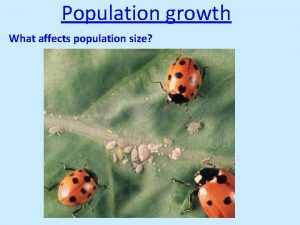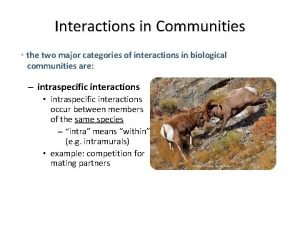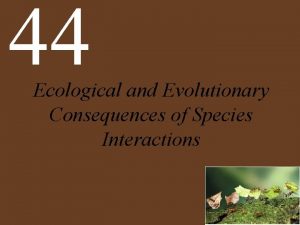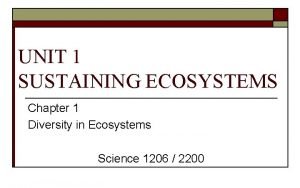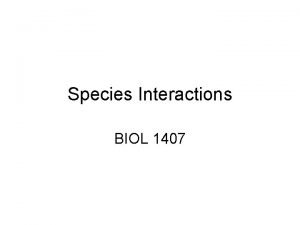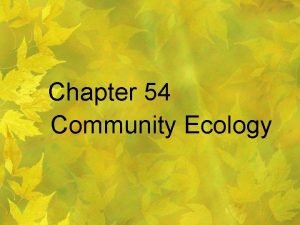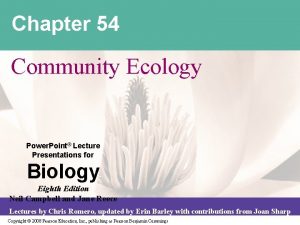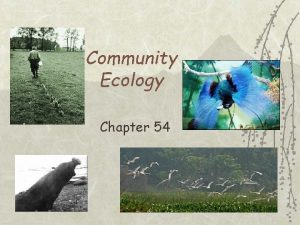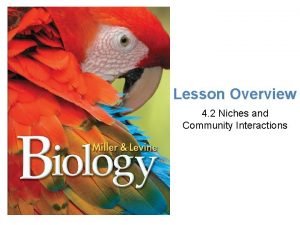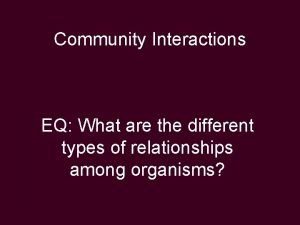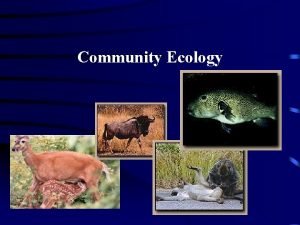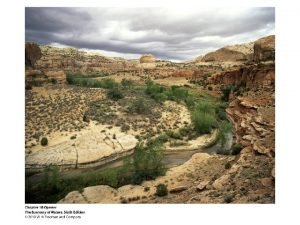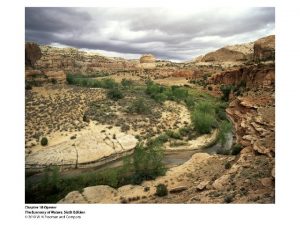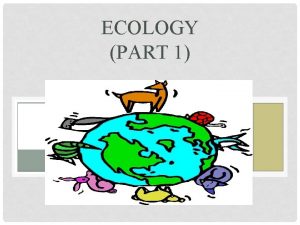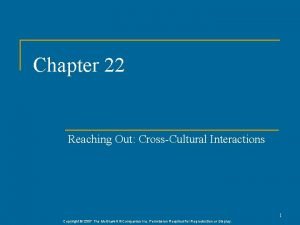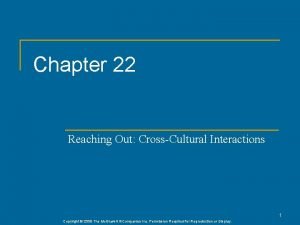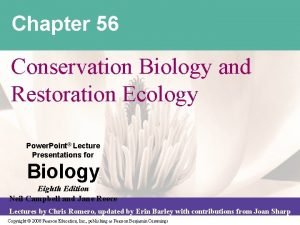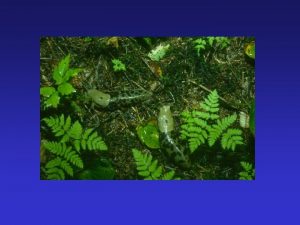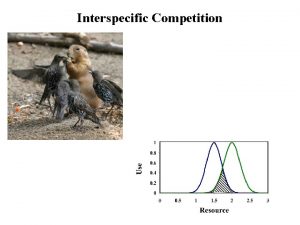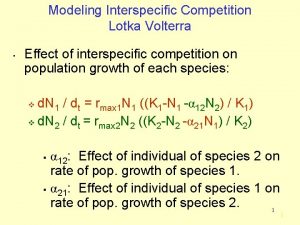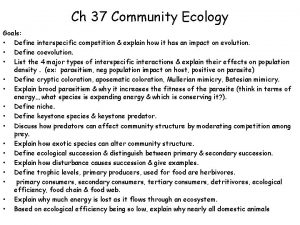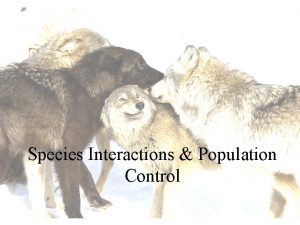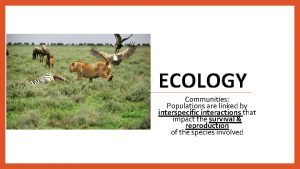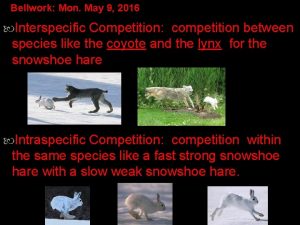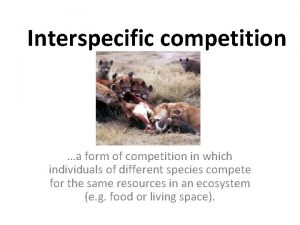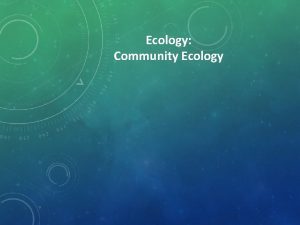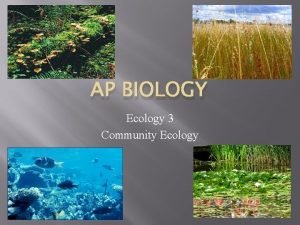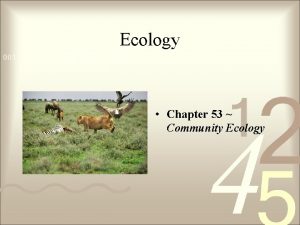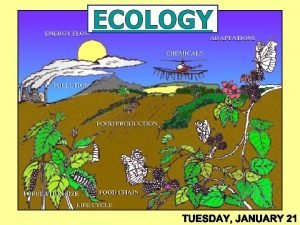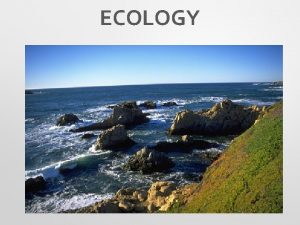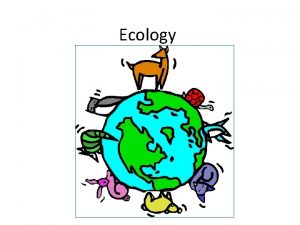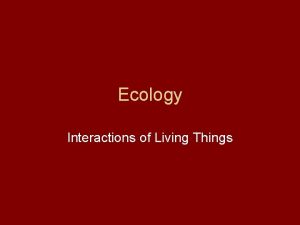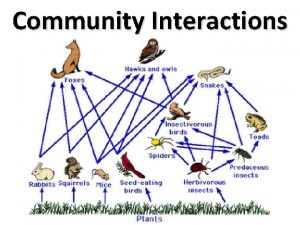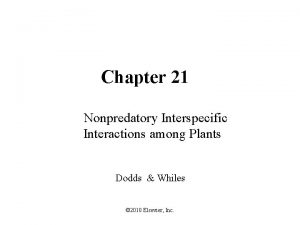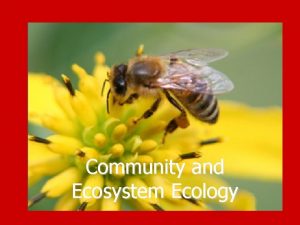Chapter 53 Community Ecology I Interspecific Interactions Competition



































- Slides: 35

Chapter 53 Community Ecology

I. Interspecific Interactions Competition – – Competitive exclusion principle Niche – fundamental vs. realized Resource partitioning Character displacement Predation – Adaptations Cryptic coloration Aposemetic coloration Mimicry

Table 53 -1

LE 53 -2 Chthamalus Balanus High tide Chthamalus realized niche Chthamalus fundamental niche Balanus realized niche Ocean Low tide

LE 53 -3 A. insolitus usually perches on shady branches. A. ricordii A. distichus perches on fence posts and other sunny surfaces. A. insolitus A. aliniger A. distichus A. christophei A. cybotes A. etheridgei

LE 53 -4 G. fortis G. fuliginosa Percentage of individuals in each size class Beak depth Santa María, San Cristóbal Sympatric populations 40 20 0 Los Hermanos 40 G. fuliginosa, allopatric 20 0 Daphne 40 G. fortis, allopatric 20 0 8 10 12 Beak depth (mm) 14 16

Figure 53 -05

Figure 53 -06

LE 53 -7 Green parrot snake Hawkmoth larva

LE 53 -8 Cuckoo bee Yellow jacket

Herbivory Parasitism – Endoparasites, ectoparasites and parasitoidism Disease - pathogens Mutualism Commensalism

II. Dominant and Keystone Species and Control of Community Species diversity – Species richness – Relative abundance Trophic structure – Food webs (Fig. 53. 13) – Limits on length Energetic hypothesis Dynamic stability hypothesis

LE 53 -11 B A C D A: 25% A: 80% Community 1 B: 25% Community 2 B: 5% C: 5% D: 25% D: 10%

LE 53 -12 Quaternary consumers Carnivore Tertiary consumers Carnivore Secondary consumers Carnivore Primary consumers Herbivore Zooplankton Primary producers Plant A terrestrial food chain Phytoplankton A marine food chain

LE 53 -13 Humans Smaller toothed whales Baleen whales Crab-eater seals Birds Leopard seals Fishes Sperm whales Elephant seals Squids Carnivorous plankton Copepods Euphausids (krill) Phytoplankton

LE 53 -14 Sea nettle Juvenile striped bass Fish larvae Fish eggs Zooplankton

Number of species 6 No. of species 5 No. of trophic links 4 6 5 4 3 3 2 2 1 1 0 0 High (control) Medium Productivity Low Number of trophic links LE 53 -15

Species with a Large Impact – Dominant species – Keystone species (Fig. 53. 16, p. 1168) – Foundation species Bottom-Up and Top-Down Controls – Bottom-Up: N V H P Nutrients are limiting factors – Top-Down: N V H P Predation is limiting factor

Number of species present LE 53 -16 20 With Pisaster (control) 15 10 Without Pisaster (experimental) 5 0 1963 ’ 64 ’ 65 ’ 66 ’ 67 ’ 68 ’ 69 ’ 70 ’ 71 ’ 72 ’ 73

LE 53 -17 Otter number (% max. count) 100 80 60 40 20 0 Sea otter abundance Number per 0. 25 m 2 Grams per 0. 25 m 2 400 300 200 100 0 Sea urchin biomass Food chain before killer whale involvement in chain 10 8 6 4 2 0 1972 1985 1989 1993 1997 Year Total kelp density Food chain after killer whales started preying on otters

Figure 53 -18

LE 53 -19 Number of plant species 8 6 4 2 0 Salt marsh with Juncus (foreground) With Juncus Without Juncus Conditions

LE 53 -20 Percentage of herbaceous plant cover 100 75 50 25 0 0 100 200 Rainfall (mm) 300 400

LE 53 -UN 1171 Polluted State Restored State Fish Abundant Rare Zooplankton Rare Abundant Algae Abundant Rare

III. Disturbance Influences Communities Definition and causes – Changes in community and removal of species – Human roles Ecological succession – Primary – Secondary

LE 53 -21 Before a controlled burn. A prairie that has not burned for several years has a high proportion of detritus (dead grass). During the burn. The detritus serves as fuel for fires. After the burn. Approximately one month after the controlled burn, virtually all of the biomass in this prairie is living.

LE 53 -22 Soon after fire. As this photo taken soon after the fire shows, the burn left a patchy landscape. Note the unburned trees in the distance. One year after fire. This photo of the same general area taken the following year indicates how rapidly the community began to recover. A variety of herbaceous plants, different from those in the former forest, cover the ground.

LE 53 -24 Pioneer stage, with fireweed dominant Dryas stage 60 Soil nitrogen (g/m 2) 50 40 30 20 10 0 Pioneer Dryas Alder Spruce Successional stage Nitrogen fixation by Dryas and alder increases the soil nitrogen content. Spruce stage

IV. Biogeographic Factors on Community Equatorial-Polar gradients Area effects – Species-area curve (p. 1176) Island equilibrium model – Size and distance from mainland – Immigration/extinction

LE 53 -25 180 Tree species richness 160 140 120 100 80 60 40 20 0 100 Trees 700 900 1, 100 500 300 Actual evapotranspiration (mm/yr) Vertebrate species richness (log scale) 200 100 50 10 500 2, 000 1, 500 1, 000 Potential evapotranspiration (mm/yr) Vertebrates

LE 53 -26 Number of species (log scale) 1, 000 10 1 1 10 103 104 105 106 Area (acres) 107 108 109 1010

li sl an d) Small island e (l g ar Large island Number of species on island Effect of island size is Im (fa m ig ri ra sl an tio d) n Far island Ex (fa tinc t ri sl ion an d) Rate of immigration or extinction al Ex ti m ncti Ex all o isl n tin an ct d) io n m (s ct tin Immigration and extinction rates Rate of immigration or extinction n io n Ex tio ra ig Number of species on island (s la ) nd n tio ) ra ig land m s Im ar i e (n m Equilibrium number n n ) tio io ra nd rat ig la ig m is m Im rge Im (la Im Rate of immigration or extinction LE 53 -27 n io d) n ti isla x E ar e (n t nc Near island Number of species on island Effect of distance from mainland

Number of plant species (log scale) LE 53 -28 400 200 100 50 25 10 5 0. 1 1 100 10 Area of island (mi 2) (log scale) 1, 000

V. Views of Community Structure Integrated hypothesis Individualistic hypothesis

Population densities of individual species LE 53 -29 Environmental gradient (such as temperature or moisture) Population densities of individual species Integrated hypothesis Number of plants per hectare Environmental gradient (such as temperature or moisture) Individualistic hypothesis 600 400 200 0 Moisture gradient Wet Trees in the Santa Catalina Mountains Dry
 Interspecific competition
Interspecific competition Examples of r strategists
Examples of r strategists Intraspecific competition
Intraspecific competition Intraspecific competition
Intraspecific competition Interspecific competition
Interspecific competition Interspecific competition
Interspecific competition Interspecific competition
Interspecific competition Example of commensalism
Example of commensalism Chapter 3 section 1 community ecology
Chapter 3 section 1 community ecology Chapter 54 community ecology
Chapter 54 community ecology Evolution and community ecology guided notes
Evolution and community ecology guided notes Biological disturbance
Biological disturbance Chapter 5 evolution and community ecology
Chapter 5 evolution and community ecology Chapter 5 evolution and community ecology answer key
Chapter 5 evolution and community ecology answer key Chapter 54 community ecology
Chapter 54 community ecology 6.1 habitats niches and species interactions
6.1 habitats niches and species interactions Niches and community interactions
Niches and community interactions 3 types of community interactions
3 types of community interactions Characteristics of monopoly
Characteristics of monopoly Perfect competition vs monopolistic competition
Perfect competition vs monopolistic competition Monopoly vs oligopoly venn diagram
Monopoly vs oligopoly venn diagram Perfect competition vs monopolistic competition
Perfect competition vs monopolistic competition Is india near the equator
Is india near the equator Population vs community ecology
Population vs community ecology Community ecology
Community ecology Definition of community ecology
Definition of community ecology Community definition ecology
Community definition ecology Ecology examples
Ecology examples Community level ecology
Community level ecology Chapter 4 section 1 population dynamics answer key
Chapter 4 section 1 population dynamics answer key Chapter 22 reaching out cross-cultural interactions
Chapter 22 reaching out cross-cultural interactions Chapter 22 reaching out cross-cultural interactions
Chapter 22 reaching out cross-cultural interactions Chapter 22 reaching out cross-cultural interactions
Chapter 22 reaching out cross-cultural interactions Unit 5 ecology
Unit 5 ecology Marine ecology
Marine ecology Chapter 56 conservation biology and restoration ecology
Chapter 56 conservation biology and restoration ecology

